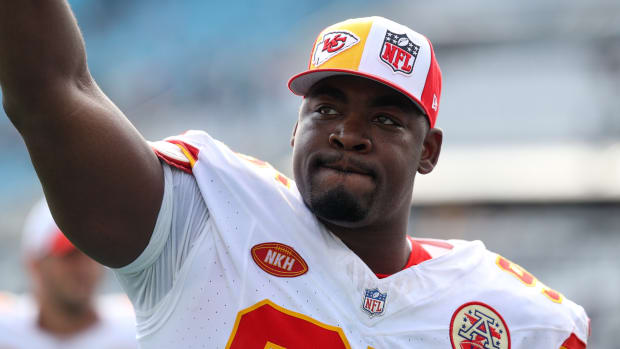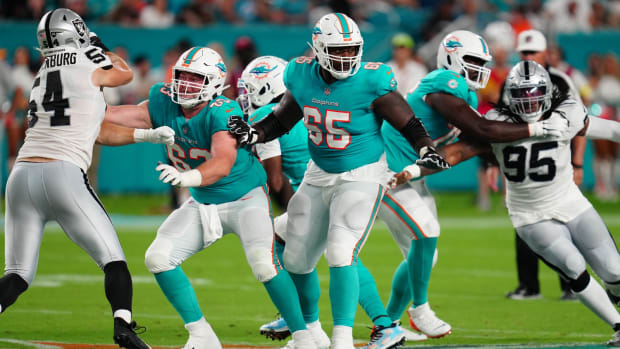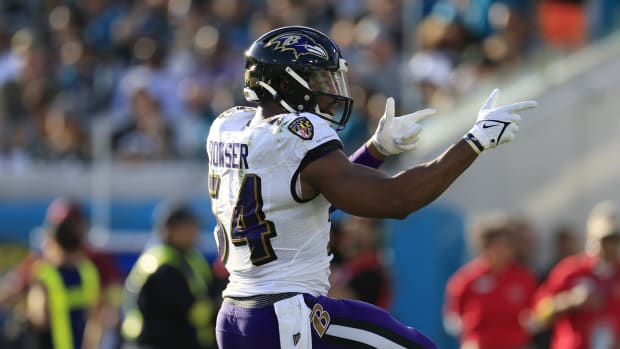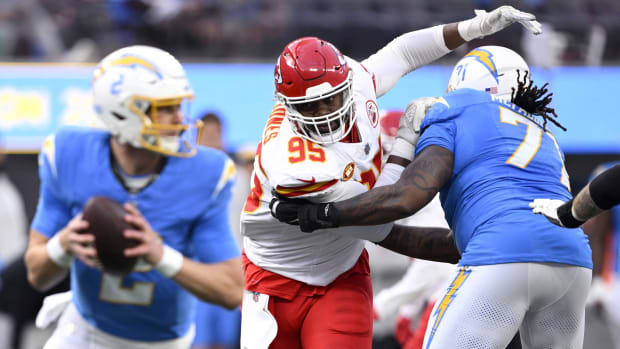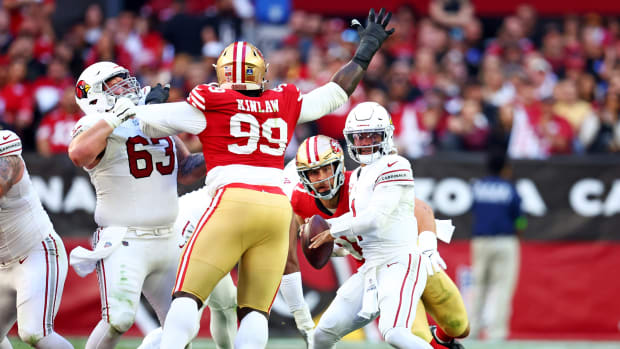Potential Legal Fallout From the Myles Garrett-Mason Rudolph Fight on Thursday Night
In a gruesome and hazardous attack on a defenseless player, Browns defensive end Myles Garrett struck Steelers quarterback Mason Rudolph in the skull with Rudolph’s helmet during Thursday’s night’s game between the Pittsburgh Steelers and Cleveland Browns at FirstEnergy Stadium. The incident occurred in the closing seconds of the game, which the Browns won 21-7.
Garrett’s strike on Rudolph, which occurred as tensions between the two players escalated, followed a play where Rudolph had completed a pass to running back Trey Edmunds. Garrett brought Rudolph down to the ground as the play ended and the two men then jostled. As Garrett and Rudolph stood up, the 6' 4", 270-pound Garrett removed Rudolph’s helmet and then whacked him in the head with it. Rudolph’s teammates, including center Maurkice Pouncey, then ran onto the field and attacked Garrett.
From the start, it was safe to assume that the NFL would issue lengthy suspensions to the players who were involved in Thursday’s melee.
Earlier this season, Oakland Raiders linebacker Vontaze Burfict received the longest suspension for an on-field infraction in NFL history after he viciously applied a helmet-to-helmet hit on a defenseless player, Indianapolis Colts tight end Jack Doyle. NFL vice president of football operations Jon Runyan suspended Burfict for 12 regular season games, plus any 2019 playoff games. The suspension was upheld on appeal.
On Friday, the NFL suspended Garrett indefinitely, with the suspension currently set for the remainder of the 2019 regular season (six games) plus any playoff games in which the 4-6 Browns may appear. The suspension could continue well into the 2020 season, pending a meeting between Garrett and NFL commissioner Roger Goodell. Garrett was also fined an undisclosed amount, with the league stressing that he “violated unnecessary roughness and unsportsmanlike conduct rules, as well as fighting, removing the helmet of an opponent and using the helmet as a weapon.”
The league also fined and suspended Pouncey for three games and fined and suspended Browns defensive tackle Larry Ogunjobi for one game. Additional suspensions could be announced in forthcoming days, as the league continues to review the matter.
In addition to player punishments, the NFL fined the Browns and Steelers $250,000 each for the dangerous brawl.
The low odds of criminal charges
Although unlikely, Garrett’s strike on Rudolph could have a legal fallout beyond the NFL. The strike appeared to meet the elements of the crime of assault. Like in other states, assault in Ohio refers to knowingly causing or attempting to cause physical harm on another person. Use of a dangerous weapon can be added to the charge. While a football helmet isn’t a weapon per se, it takes the form of a weapon when used to inflict damage on another person’s skull.
On any play during an NFL game, players knowingly inflict physical harm and sometimes cause shocking injuries. You might reason that every NFL play contains assaults. This logic doesn’t hold up under scrutiny.
Consider the fundamental goal of football offense: advance the football and score touchdowns. Now consider the fundamental goal of football defense: stop the advancement of the football and deny touchdowns. These goals invariably lead to dangerous types of physical contact on every play. The danger is only heightened in the NFL, where players are very large, muscular and fast. And they collide, often at full speed, on every play.
Sometimes players go too far in pursuing core football goals and are penalized as a result. So, what’s the difference between “football plays” and “football penalties” versus Garrett swinging a helmet on Rudolph’s exposed skull? The answer is consent.
Players consent to physical injuries related to the goals of football. No player, however, consents to being attacked with a helmet while his skull is exposed. That kind of attack has absolutely nothing to do with the sport of football or its goals.
To that point, whether Rudolph or Garrett “started” their altercation isn’t a relevant question in assessing whether Garrett may have broken the law. Self-defense as a legal justification generally requires a proportionate response to an imminent threat. Self-defense does not authorize retaliation or revenge. Even if Rudolph had provoked Garrett, Garrett had no right to swing a helmet—which likely weighs five or six pounds—at Rudolph’s skull.
So, will Garrett face criminal charges? Or how about Pouncey? The answer is almost certainly no.
There is a glaring absence of examples in American jurisprudence of professional athletes being charged with assault-like crimes for incidents that occur during games. NFL players are well aware of that point. In 2006, Tennessee Titans defensive tackle Albert Haynesworth stomped his cleats on the unprotected face of Dallas Cowboys center Andre Gurode. Gurode immediately needed medical attention and would require 30 stitches under his right eye. He went on to suffer prolonged headaches and blurred vision. It was textbook criminal assault and had nothing to do with football, but there was no charge.
U.S. law enforcement and prosecutors tend to be “hands off” when it comes to seemingly criminal acts that transpire in sports. Some commentators have expressed worry that if players were charged for crimes for their conduct during sports games, it would have a chilling effect on those sports. Players would be less willing to hit and other players would decide the risk of being charged with a crime makes the sport unappealing. Others believe that injured players would be unwilling to testify in court against opposing team players for fear of being stigmatized as a result.
There are rare exceptions to that line of thinking.
In 2004, five NBA players—Ron Artest, Stephen Jackson, Jermaine O’Neal, David Harrison and Anthony Johnson—were among those charged with misdemeanor assault in the wake of the “Malice at the Palace.” The Malice was sparked when Detroit Pistons season ticket holder John Green tossed a plastic cup of Diet Coke onto Artest, a forward on the Indiana Pacers. Artest then rushed into the stands, triggering a melee that would spill onto the court and become a riot. Attorneys for the players negotiated plea deals and the players avoided jail time. The Malice is clearly distinguishable from the Garrett incident since it involved violence against fans (some of whom inflicted violence on the players) and riot conditions.
In 2007, former Major League Baseball infielder Jose Offerman was charged with felony assault in Connecticut for an incident that took place during an Independent Atlantic League game. Offerman had charged the mound with his bat and swung and hit the opposing team’s pitcher, Matt Beech. Offerman also whacked catcher Jonathan Nathans in the skull, causing him permanent injury and vestibular damage. The criminal charge was resolved with Offerman receiving two years of probation. An important factual difference between the Offerman and Garrett situations is that Offerman inflicted devastating injuries on another player whereas Rudolph appears to be fine. Law enforcement was likely influenced by the serious injuries inflicted on Nathans.
Law enforcement and prosecutors in Canada have been more willing to bring charges than their counterparts in the U.S. Thirty-one years ago, a Canadian judge sentenced Minnesota North Stars right wing Dino Ciccarelli to one day in jail on account of him repeatedly striking Maple Leafs defenseman Luke Richardson on the head with his stick. In the early 2000s, two NHL players—Boston Bruins defenseman Marty McSorley and Vancouver Canucks forward Todd Bertuzzi—were charged with crimes in Canada for on-ice incidents. McSorley had slashed Vancouver Canucks left wing in the head during a game while Bertuzzi had smashed Colorado Avalanche forward Steve Moore’s face into the ice.
Potential torts litigation also seems unlikely
If Rudolph had been injured by Garrett’s attack, he might explore remedies under a different area of law: torts. Torts, sometimes called personal injury law, refers to an injured person suing the person(s) who caused their injuries. If successful, a torts lawsuit leads to the defendant paying the plaintiff money to make him or her “whole again,” to the extent money can produce that effect.
The most significant “sports and torts” case is former Denver Broncos safety Dale Hackbart’s successful lawsuit against the Cincinnati Bengals for an incident that occurred during a 1973 NFL game. Hackbart suffered a career-ending neck fracture at the hands of Bengals fullback Charles Clark. Clark struck Hackbart in the back of the neck while Hackbart was trying to stand up after a play. The hit had nothing to do with football—it was just a cheap and dangerous shot on a defenseless player. In finding for Hackbart, a federal appeals court noted that while NFL players assume the possibility of injuries from risks inherent in the sport of football, they don’t assume risks that are unrelated to the sport.
A court that held in favor of former Houston Rockets forward Rudy Tomjanovich applied this same logic in the aftermath of a ghastly incident during a 1977 Rockets-Los Angeles Lakers game. In the midst of an on-court confrontation between the two teams, Lakers forward Kermit Washington “sucker” punched Tomjanovich in the face, causing him catastrophic injury. Tomjanovich sued the Lakers, insisting that the they team was negligent for Washington’s actions. Tomjanovich won the trial and, prior to an appeal, reached a $2 million settlement with the Lakers.
In 1988, California Judge Thomas Crosby discussed the importance of the Tomjanovich decision in a separate case. Judge Crosby wrote:
“A verdict for Tomjanovich was clearly proper. He did assume the risk of being hit in the face by a flying elbow in the course of defending against an opponent's jump shot, suffering a painful insult to his instep by a size-16 foot descending with a rebound, or even being knocked to the court by the sheer momentum of a seven-footer driving home a slam dunk. But the scope of his consent did not extend to an intentional blow considerably beyond the expected risks inherent in basketball. Intentional fouls are part of that game. But where the intent is to injure and the force used is far greater than necessary to accomplish a legitimate objective within the scope of play, a defendant may not prevail on an assumption of risk defense.”
Does the same logic apply to Garrett’s hit on Rudolph? Arguably it does: Rudolph assumed numerous and grave health risks during Thursday’s game as those risks related to football, but he didn’t assume the risk of getting struck in the head by a helmet. Likewise, the intent of Garrett’s hit appears to have been to injure rather than accomplish any kind of meritorious football play.
That said, don’t expect Rudolph to bring lawsuit. After the game Rudolph slammed Garrett’s hit as “cowardly” and “bush league.” Rudolph is clearly angry by what happened. But he doesn’t appear to have suffered any injuries. A successful torts lawsuit would require proof of injury to Rudolph. Also, Garrett acknowledged fault after the game, admitting that he let his emotions get the best of him. That type of conciliatory comment will help to diffuse the situation. The fact-pattern, then, doesn’t forecast a legal dispute—other than very lengthy NFL suspensions.
Michael McCann is SI’s Legal Analyst. He is also an attorney and the Director of the Sports and Entertainment Law Institute at the University of New Hampshire Franklin Pierce School of Law.
Question or Comment? Email us at talkback@themmqb.com.
































